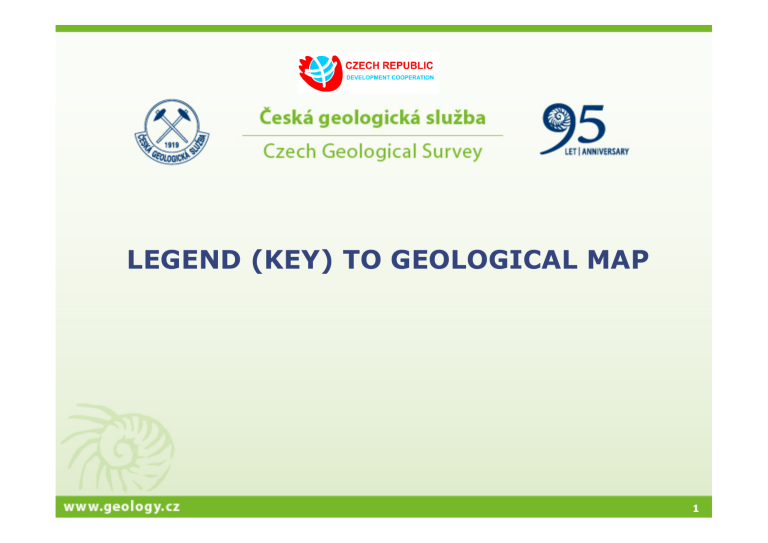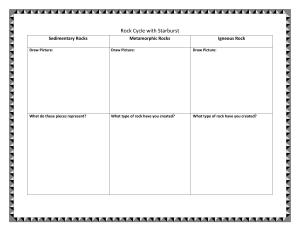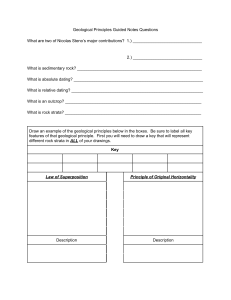
LEGEND (KEY) TO GEOLOGICAL MAP 1 Content Legend definition Legend symbology colours description index geological symbols Legend structure Compilation of legend 2 Legend definition 3 Legend is a table explaining the meanings of all colours and symbols used to represent geologic features in the geological map, cross section and litostratigraphic column. 4 Geological unit – element which is mappable and distinct from one another 5 Symbols – expresions of line and point geological elements, superposed phenomena Boundaries Tectonic lines Tectonic symbols Paleontology Alteration Exodynamic phenomena Mining …. 6 Legend symbology 7 Basic parts of description of geological unit Ordinal number (individual for each map sheet) Colored box with hatch Index Description 8 Colours of geological maps Colours in geological maps should come out from international standards. Colours commonly expresses age, hatch lithology 9 Colours suggested for stratigraphical units http://www.stratigraphy.org/index.php/ics-chart-timescale https://engineering.purdue.edu/Stratigraphy/charts/rgb.html http://pubs.usgs.gov/tm/2005/11B01/pdf/ 10 For igneous and volcanic rocks are used colours to contrast to surroundings units 11 On geologic maps that have many map units, it is sometimes impossible to maintain the standard geologic age colours Colours should be choose so the map has been well legible Showing contrast and clarity of map units and symbols Showing ages or age relationships of map units Matching or approximating colours and patterns used on nearby or adjacent maps to maintain consistency and continuity of colours and patterns among maps in a region Showing structural relationships of map units Using colours that are light enough for easy readability of the base map Do not forget that map should be nice 12 Description of geological unit Description of geological unit in legend has a descriptive (petrographic character), completed by genetic information for Quaternary sediments and volcanoclastic rocks 13 Sedimentary (volcanosedimentary) unit Litostratigraphic unit: colour, grain-size, composition characteristic attribute, name of rock(s), suplemental information 14 Sedimentary unit Litostratigraphic unit: colour, grain-size, composition characteristic attribute, name of rock(s), suplemental information White-creek Fm: 15 Lithostratigraphic units are bodies of rocks, bedded or unbedded, that are defined and characterized on the basis of their lithologic properties and their stratigraphic relations. Lithostratigraphic unit is the basic unit of geological mapping. https://engineering.purdue.edu/Stratigraphy/ strat_guide/litho.html Supergroup Group Formation Member 16 Sedimentary unit Litostratigraphic unit: colour, grain-size, composition characteristic attribute, name of rock(s), suplemental information White-creek Fm: 17 Sedimentary unit Litostratigraphic unit: colour, grain-size, composition characteristic attribute, name of rock(s), suplemental information No-name Fm: brown 18 Sedimentary unit Litostratigraphic unit: colour, grain-size, composition characteristic attribute, name of rock(s), suplemental information No-name Fm: brown fine grained 19 Sedimentary unit Litostratigraphic unit: colour, grain-size, composition, characteristic attribute, name of rock(s), suplemental information No-name Fm: brown fine grained micaceous 20 Sedimentary unit Litostratigraphic unit: colour, grain-size, composition characteristic attribute, name of rock(s), suplemental information No-name Fm: brown fine grained micaceous limonitic 21 Sedimentary unit Litostratigraphic unit: colour, grain-size, composition characteristic attribute, name of rock(s), suplemental information No-name Fm: brown fine grained micaceous limonitic sandstones 22 Sedimentary unit Litostratigraphic unit: colour, grain-size, composition characteristic attribute, name of rock(s), suplemental information No-name Fm: brown fine grained micaceous limonitic sandstones with tuffaceous admixture 23 Magmatic and metamorphic units grain-size, texture, mineral composition, name of rock(s), suplemental information 24 Magmatic and metamorphic units grain-size, texture, mineral composition, name of rock(s), suplemental information Medium-grained stromatitic biotitic migmatite with sillimanite 25 Magmatic and metamorphic units grain-size, texture, mineral composition, name of rock(s), suplemental information Medium-grained stromatitic biotitic migmatite with sillimanite 26 Magmatic and metamorphic units grain-size, texture, mineral composition (max two minerals), name of rock(s), suplemental information Medium-grained stromatitic biotitic migmatite with sillimanite 27 Magmatic and metamorphic units grain-size, texture, mineral composition, name of rock(s), suplemental information Medium-grained stromatitic biotitic migmatite with sillimanite 28 Magmatic and metamorphic units grain-size, texture, mineral composition, name of rock(s), suplemental information Medium-grained stromatitic biotitic migmatite with sillimanite 29 Index Index of geological unit is used for unique identification of legend unit in a map Generally, index is composed from body which expresses main stratigraphic and lithological information and symbols in lower and upper cases, which characterize supplemental signs The index building slightly differs for sedimentary, volcanic, igneous and metamorphic rocks 30 Sedimentary rocks te li So Body of index S – system o – series 1 – lower, 2 – middle/upper, 3 – upper 1 ls Symbols in upper and lower cases te – expressive sign (characteristic texture, mineral, colour, admixture, matrix, texture, genesis, grain size etc.) li – dominant lithology ls – lithostratigraphic or geologic unit 31 Chronostratigraphic indexes Sytem Series Index Q Quaternary Holocene Pleistocene Neogene Pliocene Miocene Qh Qp N System N2 N1 Oligocene p3 Eocene Paleocene p2 Index C pennsylvanian mississipian C2 C1 D Upper D. Middle D. Lower D. D1 D2 D3 Devonian p Paleogene Series Carboniferous S Silurian Pridoli Ludlow Wenlock S4 S3 S2 Llandovery S1 O J Upper O. O1 J3 J2 J1 Middle O. Lower O. O2 O3 Є T Furongian Є4 Upper T. Middle T. Lower T. T3 T2 T1 P Series 3 Series 2 Terrenuvian Є3 Є2 Є1 Erathem Lopingian P3 Neoproterozoic NP Guadalupian P2 Mezoproterozoic MP Cisuralian P1 Paleoproterozoic PP p1 K Cretaceous Upper C. Lower C Jurassic Upper J. Middle J Lower J. Triassic Permian K2 K1 Ordovician Cambrian 32 Important sedimentary textures and gentic feature (te) bd if bi ca cb dt e f fy fw g ch co l la mv my bo vc ry s si t biodetritic ichnofossil existence of bitumene carbonaceous rocks, admixture cross bedding detritic eolian sediment, admixture fluvial sedimet flysh sediment fossil weathering glacial sediments chaotic texture coral sediments limnic sediments lamination massive texture mylonitization biogenic rock variocoloured rhytmite spotted silicification tuffaceous admixture Sedimentary lithology (li) a b d di e cy sh c l ld s q r ra ch m sg g co li w arcose breccia dolomite diatomite evaporite clay, claystone shale conglomerate loes lydite sandstone quartzite siltstone radiolarite chert marl spongilite gravel coal limestone grauwacke 33 Coherent volcanic rocks te mi 1 ls rSo Pyroclastic rocks ge 1 ls rSo Body of index r – rock, small letter of Greek alphabet S – system o – series 1 – lower, 2 – middle/upper, 3 – upper, (used according to stage of knowledge) Symbols in upper and lower cases te – texture mi – characteristic mineral ge – genetic type ls – litostratigraphic (regional) unit 34 Coherent volcanic rock (r) α β βα η ζ φ υ ω ρ ψ τα τβ τ andezite bazalt basaltic andezite bazanite dacite foidite phonolite pikrite, polzenite rhyolite tefrite trachyandezite trachybazalt trachyte Pyroclastic rocks - genetic types (ge) b ig l la p s t breccia ignimbrite lappili-stone lahar pumice scoria tuff Textural and genetic specification of volcanic rocks (te) f gt la an mv my p pl gs v vl s at e ep fr fluidal granulate lamination amygdaloidal massive mylonitic porphyric pillow lavas glassy vitritophyric variolitic stratification altered effusive epiclastic freatomagmatic 35 Igneous (plutonic)rocks te gs rSmi ls Metamorphic rocks te gs Rmi ls Body of index r – rock, small letter of Greek alphabet S – system mi – significant minerals Body of index R – rock, large (orthometamorphites) or small (metasediments) letter in italic mi – significant minerals Symbols in upper and lower cases te – texture or other expressive sign (colour) gs – grain size ls – lithostratigraphic or geologic unit Symbols in upper and lower cases te – texture or other expressive sign (colour) gs – grain size ls – lithostratigraphic or geologic unit 36 Igneous (plutonic) rocks (r) ι δ δq ν νδ γ γδ hσ aν si χ pν κ σ γπ νπ γδπ ξπ δπ pσ ξ ξδ ξν δ´ γ´ γδ´ ξ´ aplite diorite quartz diorite gabbro gabbrodiorite granite granodiorite hornblendite hyperite quartz vein lamprophyre norite pegmatite peridotite porphyric microgranite porphyric microgabbro porphyric microgranodiorite porphyric microsyenite porphyric mikrodiorite pyroxenite syenite, monzonite syenodiorite syenogabbro diorite dyke granite dyke granodiorite dyke syenite dyke Textures and expressive signs of igneous rocks (te) al at s b en l la ml mv my p alkalic altered schistosed brecciated enclave leukocratic lamination melanocratic massive mylonitic porphyric Grain size (gs) m f m c massive fine-grained medium-grained coarse-grained 37 Metamorphic rocs (R) A s E e ph νA Gr h v q mβ M G g S sk m B amphibolite schist eklogite erlan, calc-silicate rock phyllite gabbroamfibolite granulite hornfels crystallic limestone (marble) quartzite metabazalt migmatite orthogneiss gneiss, paragneiss serpentinite skarn mica schist greenschist Textures and expressive signs of metamorphic rocks (te) a ca f i c l M ml mv my n o la po q s agmatitic carbonatic phlebitic injected cataclastic leucocratic migmatitized melanocratic massive mylonitic nebulitic ophtalmitic, augen laminated porhyroblastic quartzitic stromatitic 38 Minerals (mi) mineral index abb.* actionolite ak Act albite ab Ab almandine al Alm hornblende h Amp analcime ac Anl andalusite ad And andesine as anhydrite ah Anh ankerite ai Ank anorthite an An anortoklase ao Ano antophylite ay Ath apatite ap Ap arfvedsonite af Arf augite ag Aug axinite ax Ax baryte ba Brt beryl be Brl biotite b Bt bronzite bz brucite bc bytownite by Brc zinvaldite zw Znw cordierite co Crd datolite da Dat dialage dl diopside dp Di dolomite do Dol aegirine ae Aeg enstatite en En epidote e Ep lepidolite le phlogopite pl Phl leptochlorite lc fluorite fl Fl leucite l fuchsite fu limonite lm gedrite gd Ged litionite li glaucophane gl Gln magnetite mt glaukonite gk Glt magnezite mg graphite gf Gr marcasite ma garnet g Grt talk grosular gr Grs melilite halloysite hl haüyn ha Lpd Lct Lm Mag Mgs pyrite py Py pyrope po Prp pyroxene p Pyx rutile r Rt gypsum gi Gp sanidine sa Sa sericite s Ser Mrc serpentine se Srp tk Tlc siderit sr Sd me Mll sillimanite si Sil microcilen mi Mc scapolite sk Scp Hyn monazite mz Mnz sodalite so Sdl hedenbergite he Hd monticellite mc Mtc spessartine sn Sps haematite hm Hem montmorilonite mo Mnt spinel sp Spl humite hu Hu muscovite m Ms staurolite st St hypersthene hy Hyp nepheline n Nph stilpnomelane sm Stp nosean no Nsn halite sl Hl oligoklase ol thuringite th olivine o titanaugite ta omfacite om opal op chalcedona cl chamosite cm chiastolite ch chlorite c chloritoide cd Chm Chl Cld chromite cr Chr orthite or ilmenite i Ilm orthoclase ok Ol Omp Opl Or titanite ti titanomagnetite tm topaz to tremolite tr Ttn Tpz Tr jadeite j Jd otrelite ot tourmaline t Tur calcite ca Cal ozokerite oz wollastonite wo Wo cancrinite cc Ccn paragonite pa Pg wolframite w kaolinite k Kln periklase pe Per zeolite z cassiterite cs Cst phillipsite ph Php zircon zr corundum co Crn plagioclase pg Pl zoisite zt Zo quartz q Qz prehnite pr Prh feldpars f Fsp cyanite ky Ky pumpellyite pu Pmp labradore la pyrhotine pn Po Zeo Zrn 39 Exercise – creation of legend index Link to legend Link to index 40 Map symbols - expreses aerial, line and point geological phenomena superposed on geological units. • • • • • • • • Lithological (unit) boundaries Tectonic lines Structural elements Paleontological symbols Superposed geological and geodynamic phenomena Occurrence and exploitation of raw materials Hydrogeological elements Documentation symbols 41 Lithological boundaries 42 Tectonic lines 43 Structural elements 44 Paleontological symbols 45 Superposed geological and geodynamic phenomena 46 Occurrence and exploitation of raw materials 47 Hydrogeological elements 48 Documentation symbols 49 CGS has prepared own symbols library Microstation color table Microstation rsc library Microstation cell library 50 True Type Fonts ESRI style ArcMap Symbol Levels 51 Sources of geological symbols Symbols library Corel Draw http://www.geologynet.com/corel.htm http://pangaeasci.com/index.php?page=rfill http://pubs.usgs.gov/of/1995/ofr-95-0526/downloads/ Complete library USGS Digital Cartographic Standard for Geologic Map Symbolization http://ngmdb.usgs.gov/fgdc_gds/geolsymstd.php 52 Arc GIS default library 53 Legend structure 54 Regional approach 55 Chronostratigraphical approach 56 57 Legend is compiled in logical structure according to regional-geologic and chronostratigraphic units Logical blocks are introduced by heading and subheadings expresing regional (lithostratigraphic) and chronostratigraphic classification 58 Regional Hiearchy REGIONAL SYSTEM REGION Province Area Regional units are unit with similar geological evolution and compositon and related to specific region 59 Chronostratigraphic Hiearchy Chronostratigraphic units are bodies of rocks, layered or unlayered, that were formed during a specified interval of geologic time ERATHEM SYSTEM Series Stage 60 How to compile a geological legend? Graphic version Excel Word Corel Draw … combined with hand writing 61 For manuscript OK, but for GIS processing insufficient 62 Geological Unified Legend 63 Parameters of legend´s feature table Technical parameters Units description Chronostratigraphic data Regional data Existence on map sheet 64 Technical parameters Leg_ID – unique identification of legend unit, integer No, labelling of polygon in the geological map Order No – sequence No in accordance with geology, integer No Index – syntax of geological index in technical record <CLR black='97'><SUB>k </SUB></CLR>CP<CLR black='95'><SUB>b</SUB></CLR> Colour, hatch – number (code) from library link to colour link to hatch 65 Description of geological unit Unit_DCSR - petrographic description of rock(s) in unified legend (colour, grain-size, composition characteristic attribute, name of rock(s), suplemental information) Map_Order - order (and existence) on the given map sheet Map_spec - difference from desription in unified legend 66 Chronostratigraphic units – the bodies of rocks that includes all rocks formed during a specific interval of geologic time, and only those rocks formed during that time span. Erathem Sytem Series Stage Two columns - FROM and TO - should be in legend table http://www.stratigraphy.org/upload/bak/chron.htm 67 Regional Units – geological unit of simillar evolution related to some geographic region. The size and the borders of each region are defined by geologically significant boundaries and by the occurrence of simillar geologic processes. Region Province Area 68 Lithostratigraphical Units Group - a grouping of adjacent formations, sharing some shared lithological charactersitics or genesis. Formation - a mappable unit with relatively homogeneous lithological characteristics which allow it to be distinguished from adjacent formations. Member - a subdivision of a formation; these may be laterally discontinuous. Bed - a lithologically distinct horizon or layer 69 Exercise – preparation of legend´s table Link to table Link to colours Link to hatch Link to legend 70 Questions? 71




